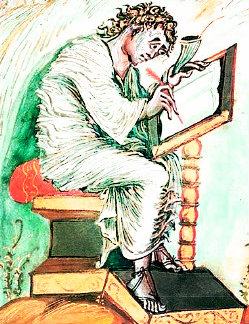Carolingian Art
750 - 985
Art of the Carolingian period is darkly mystical, infused with an ethereal passionate intensity.

Carolingian art centered around Manuscript Illumination, which thrived in Charlemagne's empire. Carolingian art survives in illuminated manuscripts, sculpture, jewlery and architecture. Craftmen and artists were commisioned by the emperor and vatican. During the seventh and eighth centuries illuminated manuscripts were produced in special buildings adjacent to the monastic centers, called scriptoriums. It is because of the monasteries that we have any record of the previous three or four centuries. The monks were fanatical about preservation and carefully preserved almost all writing, carvings, and illuminations from the preceding centuries. During the mayhem of the period from the fifth to the eighth century the monasteries were like isles of calm in a sea of chaos. They were the one place that learning, art instruction and science took place on a continuous basis. The clergy endeavored to maintain centers of learning and training even when threatened by the ravage of war. They were determined to preserve early Christian history for future generations. The monks did their best to devotedly embellish the books which came into their hands.
Not until after the first churches were constructed and Christianity represented no longer a sect but the ruling state religion, could Christian art began to develop. The symbolic element, which had been borrowed from the ancient world, became less prominent, and the sacred personages of Christian art receive their fixed types. This development is represented in Manuscript Illumination. According to Medieval historian, Julia De Wolf Addison, "In these early works the whole tremendous power of the church is fully expressed. The heads and faces lack individuality, and are outlined and emphasized with hard, unsympathetic black lines; the colouring is sallow and the expression stolid. Any attempt at delineating emotion is grotesque, and grimacing. The beauty, for in spite of all these drawbacks there is great beauty"
The early Christian
illuminators
favored morose and emaciated figures, hollowed cheeks and deep-set
eyes, wide and intense, filled with passion for Christ. The
miniature painting of the Irish, Gallic, and German monks was a melding
together of painting and calligraphy. From the scrolls and flourishes
purely calligraphic human forms are constructed. These early
depictions were severe as judges with pitiless dignity, they
stare from the pages like threatening tables of law, demanding
submission, fear, and obedience, but according neither mercy, comfort,
not redemption.
After Christianity had spread throughout the length and breadth of the empire, the emperor created his own artistic institutions and his own system of patronage. Charlemagne desired to re-establish the art and cultural accomplishments of classical Rome. He supported numerous artistic and cultural endeavors, including monastic centers that were established to create and reproduce illuminated manuscripts. These early artists were Franks who had modeled their style after the works of Greek, Roman and Middle Eastern artists. They strove to capture the mysterious and mystical nature of early Christianity. The church made use of a wide range of art-works for spiritual comfort and instruction.
Require more facts and information about Carolingian art centered
and Manuscript Illumination? Poke around every nook and cranny of the
known universe for information this subject.
Search Here
© HistoryofPainters.com If you like this page and wish to share it, you are welcome to link to it, with our thanks.
If you feel you have worthwhile information you would like to
contribute we would love to hear from you. We collect essential
biographical information and artist quotes from folks all over the
globe and appreciate your participation. When submitting please, if
possible, site the source and provide English translation. Email to
millardmulch@gmail.com